
Tokaji or Tokay is the name of the wines from the Tokaj wine region in Hungary or the adjoining Tokaj wine region in Slovakia. This region is noted for its sweet wines made from grapes affected by noble rot, a style of wine which has a long history in this region. The "nectar" coming from the grapes of Tokaj is also mentioned in the national anthem of Hungary.
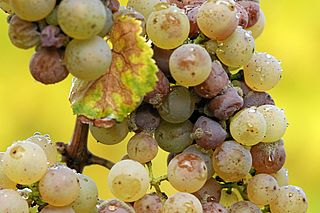
Noble rot is the beneficial form of a grey fungus, Botrytis cinerea, affecting wine grapes. Infestation by Botrytis requires moist conditions, but if the weather stays wet, the damaging form, "grey rot", can destroy crops of grapes. Grapes typically become infected with Botrytis when they are ripe. If they are then exposed to drier conditions and become partially raisined, this form of infection is known as noble rot. Grapes picked at a certain point during infestation can produce particularly fine and concentrated sweet wine. Wines produced by this method are known as botrytized wines.
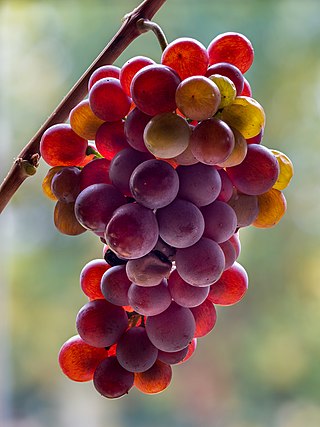
Pinot Gris, Pinot Grigio or Grauburgunder is a white wine grape variety of the species Vitis vinifera. Thought to be a mutant clone of the Pinot Noir variety, it normally has a grayish-blue fruit, accounting for its name, but the grapes can have a brownish pink to black and even white appearance. The word pinot could have been given to it because the grapes grow in small pinecone-shaped clusters. The wines produced from this grape also vary in color from a deep golden yellow to copper and even a light shade of pink, and it is one of the more popular grapes for skin-contact wine.

Furmint is a white Hungarian wine grape variety that is most noted widely grown in the Tokaj-Hegyalja wine region where it is used to produce single-varietal dry wines as well as being the principal grape in the better known Tokaji dessert wines. It is also grown in the tiny Hungarian wine region of Somló. Furmint plays a similar role in the Slovakian wine region of Tokaj. It is also grown in Austria where it is known as Mosler. Smaller plantings are found in Slovenia where it is known as Šipon. The grape is also planted in Croatia & Serbia, where it is known as Moslavac. It is also found in Romania and in former republics of the Soviet Union. Furmint is a late ripening variety. For dry wines the harvest starts usually in September, however sweet wine specific harvest can start in the second half of October or even later, and is often affected by Botrytis.

Tokaj is a historical town in Borsod-Abaúj-Zemplén county, Northern Hungary, 54 kilometers from county capital Miskolc. It is the centre of the Tokaj-Hegyalja wine district where Tokaji wine is produced.

Borsod-Abaúj-Zemplén is an administrative county in north-eastern Hungary, on the border with Slovakia. It shares borders with the Hungarian counties Nógrád, Heves, Hajdú-Bihar and Szabolcs-Szatmár-Bereg. The capital of Borsod-Abaúj-Zemplén county is Miskolc. Of the seven statistical regions of Hungary it belongs to the region Northern Hungary.
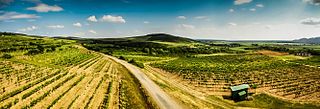
Tokaj wine region is a wine-growing region located in south-eastern Slovakia and north-eastern Hungary. The two vine-growing areas were once part of the greater Tokaj wine region of the Kingdom of Hungary. Following the Treaty of Trianon, a smaller part became part of Czechoslovakia, and after 1993, Slovakia. The majority of the region remained part of Hungary.

Hárslevelű, also called Lipovina, Frunza de tei, Lindenblättriger and Feuille de Tilleul is a grape variety from the Pontian Balcanica branch of Vitis vinifera.
Hungarian wine has a history dating back to the Kingdom of Hungary. Outside Hungary, the best-known wines are the white dessert wine Tokaji aszú and the red wine Bull's Blood of Eger.
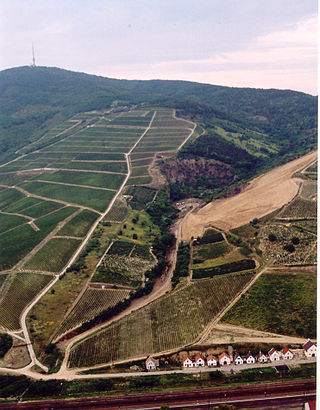
Tokaj wine region or Tokaj-Hegyalja wine region is a historical wine region located in northeastern Hungary and southeastern Slovakia. It is also one of the seven larger wine regions of Hungary. Hegyalja means "foothills" in Hungarian, and this was the original name of the region.

Flor in winemaking, is a film of yeast on the surface of wine, important in the manufacture of some styles of sherry. The flor is formed naturally under certain winemaking conditions, from indigenous yeasts found in the region of Andalucía in southern Spain. Normally in winemaking, it is essential to keep young wines away from exposure to air by sealing them in airtight barrels, to avoid contamination by bacteria and yeasts that tend to spoil it. However, in the manufacture of sherries, the slightly porous oak barrels are deliberately filled only about five-sixths full with the young wine, leaving "the space of two fists" empty to allow the flor yeast to take form and the bung is not completely sealed. The flor favors cooler climates and higher humidity, so the sherries produced in the coastal Sanlúcar de Barrameda and El Puerto de Santa María have a thicker cap of flor than those produced inland in Jerez. The yeast gives the resulting sherry its distinctive fresh taste, with residual flavors of fresh bread. Depending on the development of the wine, it may be aged entirely under the veil of flor to produce a fino or manzanilla sherry, or it may be fortified to limit the growth of flor and undergo oxidative aging to produce an amontillado or oloroso sherry.
Tōkai in Japanese may refer to:
Sauvignon vert is a white wine grape of the species Vitis vinifera prevalent in the Italian region of Friuli, and adjacent territories of Slovenia. It is widely planted in Chile where it was historically mistaken for Sauvignon blanc. The grape is distinct from the California planting of Muscadelle which is also called Sauvignon vert.
Malá Tŕňa is a village and municipality in the Trebišov District in the Košice Region of south-eastern Slovakia.
Tokayer may refer to one of several wines or wine grapes:

Slovak wine is produced in the southern part of Slovakia, which is divided into 6 wine-producing areas. Although Slovak wines except Tokaj are not well-known internationally, they are popular domestically and in neighbouring countries. The best wines are produced by medium-sized wineries with their own vineyards, with white wine production being most dominant, including the full range of historic sweet wines - ice wine, straw wine, and botrytized wine.
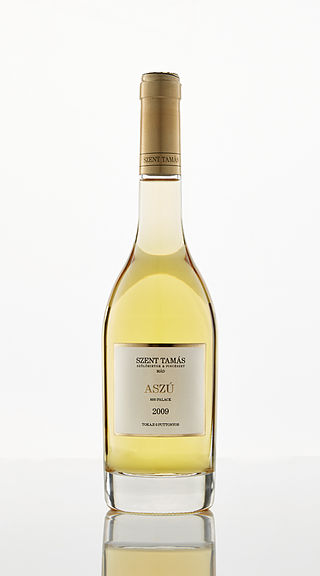
Puttonyos is a unit for the level of sugar in Hungarian Tokaji and Slovak Tokaj dessert wine. It is traditionally measured by the number of hods of sweet botrytised or nobly rotted grapes added to a barrel of wine, but is now measured in grams of residual sugar. The puttony was actually the 25 kg basket or hod of Aszú grapes, and the more added to the barrel of wine, the sweeter the eventual wine. Measurement ranges from 3 to 6 Puttonyos. A Tokaji made entirely from Aszú grapes is not labeled using the Puttonyos system but is known as Eszencia.

Lazarus von Schwendi, Barón de Hohenlandsberg was a military commander in the Army of the Holy Roman Empire. He was important for the development of Alsatian viticulture; among his own vineyards in the region were Château de Lupfen-Schwendi and Château du Hohlandsbourg.












